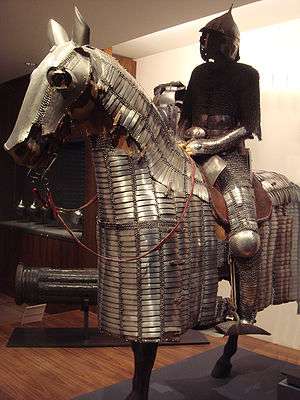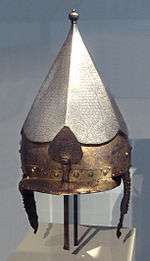Ottoman–Mamluk War (1516–17)
| ||||||||||||||||||||||
The Ottoman–Mamluk War of 1516–1517 was the second major conflict between the Egypt-based Mamluk Sultanate and the Ottoman Empire, which led to the fall of the Mamluk Sultanate and the incorporation of the Levant, Egypt and the Arabian Peninsula as provinces of the Ottoman Empire.[1] The war transformed the Ottoman Empire from a realm at the margins of the Islamic world, mainly located in Anatolia and the Balkans, to a huge empire encompassing the traditional lands of Islam, including the cities of Mecca, Cairo, Damascus and Aleppo. It continued to be ruled however from Constantinople.[2]
Background
The relationship between the Ottomans and the Mamluks had been adversarial since the Fall of Constantinople to the Ottomans in 1453: both states vied for control of the spice trade, and the Ottomans aspired to eventually taking control of the Holy Cities of Islam.[3] An earlier conflict, which lasted from 1485 to 1491, had led to a stalemate.
By 1516, the Ottomans were free from other concerns—Sultan Selim I had just vanquished the Safavid Persians at the Battle of Chaldiran in 1514[2]—and turned their full might against the Mamluks, who ruled in Syria and Egypt, to complete the Ottoman conquest of the Middle East.[2]
Operations

The war consisted of several battles. The Mamluk army was rather traditional, mainly consisting in cavalry using bows and arrows, whereas the Ottoman army, and especially the Janissaries, was quite modern, using arquebus.[4] The Mamluks remained proud in their tradition and tended to disregard the usage of firearms.[5][6]
Operations in the Levant (1516)
The Ottomans first captured the city of Diyarbekir in southeastern Anatolia.[2] The Battle of Marj Dabiq (24 August 1516) was decisive, in which the Mamluk ruler Kansuh al-Ghuri was killed.[2] The Ottomans apparently outnumbered the Mamluks by a factor of 3 to 1.[6] Syria fell under the rule of the Ottomans with this single battle.[6]
The Battle of Yaunis Khan occurred near Gaza (1516) and was again a defeat for the Mamluks.
Operations in Egypt (1517)

Al-Ghuri's successor as Mamluk sultan, Tuman Bay, frantically recruited troops from various classes of society and Bedouins, and attempted to equip his armies with some amount of cannons and firearms, but all at the last minute and on a limited scale.[5][6] Finally, at the doorstep of Cairo, the Battle of Ridaniya (24 January 1517) took place, in which the Ottoman commander Hadım Sinan Pasha lost his life.[7] In this battle, Selim I and Tuman Bay faced each other. The firearms and guns deployed by Tuman Bay turned out to be almost useless, as the Ottomans managed an attack from the rear.[6]
The campaign had been supported by a fleet of about 100 ships that supplied the troops during their campaign to the south.[8]
A few days later, the Ottomans captured and sacked Cairo,[6] capturing Caliph Al-Mutawakkil III.[9] Tuman Bay regrouped his troops in Giza, where he was finally captured and hanged at the gate of Cairo.[10][2]
As a consequence the Sharif of Mecca also submitted to the Ottomans, placing the holy cities of Mecca and Medina under Ottoman rule.[2] Ottoman power extended as far as the southern reaches of the Red Sea, although control of Yemen remained partial and sporadic.[2]
Consequences

Mamluk culture and social organization persisted at a regional level, and the hiring and education of Mamluk "slave" soldiers continued, but the ruler of Egypt was an Ottoman governor protected by an Ottoman militia.[2][11] The fall of the Mamluk Sultanate effectively put an end to the Portuguese–Mamluk naval war, but the Ottomans then took over the attempts to stop Portuguese expansion in the Indian Ocean.
The conquest of the Mamluk Empire also opened up the territories of Africa to the Ottomans. During the 16th century, Ottoman power expanded further west of Cairo, along the coasts of northern Africa. The corsair Hayreddin Barbarossa established a base in Algeria, and later accomplished the Conquest of Tunis in 1534.[2]
Following his capture in Cairo, Caliph Al-Mutawakkil III was brought to Constantinople, where he eventually ceded his office as caliph to Selim's successor, Suleiman the Magnificent.[10] This established the Ottoman Caliphate, with the sultan as its head, thus transferring religious authority from Cairo to the Ottoman throne.[9]
Cairo remained in Ottoman hands until the 1798 French conquest of Egypt, when Napoleon I claimed to eliminate the Mamluks.[12]
See also
References
- ↑ Dictionary of Battles and Sieges by Tony Jaques xxxiv
- 1 2 3 4 5 6 7 8 9 10 The Ottoman Empire: A Short History by Saraiya Faroqhi p.60ff
- ↑ Ottoman seapower and Levantine diplomacy in the age of discovery by Palmira Johnson Brummett p.52ff
- ↑ Daily Life in Ancient and Modern Cairo by Joan D. Barghusen, Bob Moulder p.41
- 1 2 Firearms: a global history to 1700 by Kenneth Warren Chase p.104
- 1 2 3 4 5 6 The Cambridge history of Egypt by M. W. Daly,Carl F. Petry p.498ff
- ↑ E. J. Brill's first encyclopaedia of Islam, 1913–1936 by Martijn Theodoor Houtsma p.432
- ↑ Ottoman seapower and Levantine diplomacy in the age of discovery by Palmira Johnson Brummett p.110
- 1 2 Drews, Robert (August 2011). "Chapter Thirty – The Ottoman Empire, Judaism, and Eastern Europe to 1648" (PDF). Coursebook: Judaism, Christianity and Islam, to the Beginnings of Modern Civilization. Vanderbilt University.
- 1 2 Muir, William (1896). The Mameluke; Or, Slave Dynasty of Egypt, 1260-1517, A. D. Smith, Elder. pp. 207–13.
- ↑ Islamic Monuments in Cairo: The Practical Guide by Caroline Williams p.6
- ↑ Cairo by André Raymond p.189
